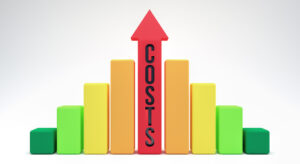 I don’t know about your small business. But for us? We haven’t been very disciplined about raising prices during the pandemic.
I don’t know about your small business. But for us? We haven’t been very disciplined about raising prices during the pandemic.
So even if our costs rose? We sort of ignored that. We were more concerned with helping people get through the last couple of years. Helping readers of our blog and then our clients get PPP loans, for example. And helping folks maximize employee retention credits.
And when the pandemic or regulatory changes pushed up costs? Okay. Keep this under your hat. It’s a little embarassing. Because we’re accountants. But we also pretty much ignored that. We were doing tax returns.
And so now after a couple of years of mostly flat prices, we need to get serious about repricing for inflation. And why I’m talking about this openly in a blog post?
Well, I am very sorry to suggest yet another task for your crowded to-do list. But I suspect you too may need to think about how to raise your prices for the effects of inflation.
But let’s go over the arithmetic and the accounting.
Why You Need to Raise Your Prices
The rationale for raising your prices? Well, if you haven’t yet experienced it in a big way, inflation is coming.
But probably? You’ve already been experiencing inflation. Stuff costs more now. People, Technology. Insurance. Rent.
And then the other issue that you may be confronting? The way you may have compensated for inflation in past? You know, just making it up on volume? So by selling more?
Supply and capacity constraints maybe won’t work in this environment. At least for a while. (See this article from Forbes.)
Accordingly, to stay economically viable? You may have to rise prices. Regularly. Diligently.
A Really Simple Example: What Not to Do
Let me construct a really simple example of what you don’t want to happen.
Let’s assume your revenues run $1,000,000, your cost of goods sold runs $500,000, and your overhead (rent, salaries, advertising and so on) run $300,000.
That means you make $200,000 a year if things work as you want. Now probably you use a chunk that $200,000 of profit to grow your business. We both know that’s the way small business works.
But let’s ignore that complexity. And with that simplification, your baseline year looks like this:
| Baseline Year | |
| Revenues | $1,000,000 |
| Less: | |
| Cost of Goods Sold | $500,000 |
| Salaries, Rent, Advertising, Etc. | $300,000 |
| Total Expenses | $800,000 |
| Profits | $200,000 |
That’s pretty good, right? I agree.. But danger lurks.
What Inflation Does to your Profitability
The problem you face now is how to respond to inflation. Probably your costs of goods sold is inflating. Maybe even sharply.
And then your overhead costs—salaries, rent, advertising and so on–are surely coasting up, too.
If cost of goods sold increases by five percent and overhead costs increase by four percent for each of the next couple of years—and you don’t adjust your prices—things might be pretty bleak, as shown below.
| After One Year of Inflation in costs | After Two Years of Inflation in costs | |
| Revenues | $1,000,000 | $1,000,000 |
| Less: | ||
| Cost of Goods Sold | $525,000 | $551,000 |
| Salaries, Rent, Advertising, Etc. | $312,000 | $324,000 |
| Expenses | $837,000 | $875,000 |
| Profits | $163,000 | $125,000 |
Just to point out the obvious: For the baseline year, cash profits equal $200,000.
But after two years of steady inflation, cash profits shrink to $125,000 if you can’t raise your prices.
That’s brutal.
And this sidebar because some business owners and most non-business owners miss this point: Those cash profits do not equate to owner wages.
Some of the money represents owner wages. But some of it represents payroll taxes. Some of it represents the fringe benefits like the employees get. And much of it goes to grow the business (by investing in inventory, fixtures and equipment.)
How Price Bumps Fix Profitability Problems
You can see what you need to do: You need to raise your prices so you don’t continually experience shrinking profits
Suppose you increase your prices by four percent, across the board.
In that situation, even if cost of goods sold increase by five percent and overhead costs increase by four percent for each of the next couple of years, things look way better.
| After One Year of Inflation | After Two Years of Inflation | |
| Revenues | $1,040,000 | $1,082,000 |
| Less: | ||
| Cost of Goods Sold | $525,000 | $551,000 |
| Salaries, Rent, Advertising, Etc. | $312,000 | $324,000 |
| Expenses | $837,000 | $875,000 |
| Profits | $203,000 | $207,000 |
Which probably shows you what you need to do. And what we need to do. And for the record? I agree regularly raising your prices to deal with inflation isn’t very pleasant.
But the pandemic changed a lot of stuff. And getting used to dealing with the impact of inflation on your profit margins and bottomline profits? Yeah, probably just another new task you need to deal with. Sorry.
Related Blog Posts
How to Grow Your Small Business
Hidden Magic of Arithmetic Growth
Pricing Small Business Services Profitably
Hi Stephen,
I think you were reading my mind. I was just thinking about this as we are nearing November. I upped a few prices last year but the ratio was less than inflation. Another thing is you can try to add a little “value” with the price increase.
Thank you for the reminder to go for it this year and I love your chat.